Embrace Serenity: Crafting a Stunning Moody Green Bedroom Aesthetic
Your bedroom should be a sanctuary—a peaceful haven where you can unwind, recharge, and find tranquility after a long day. Yet, achieving that perfect serene atmosphere, especially when working with the nuanced beauty of green tones, can sometimes feel like a delicate balance. The goal is to create a space that is both profoundly calming and subtly impactful, striking the sweet spot between gentle serenity and sophisticated depth.
This comprehensive guide will show you how the power of color psychology, combined with thoughtful design choices, can transform your sleeping space into the restful oasis you’ve always envisioned. The best part? You don’t need a lavish budget or professional designers to achieve this look. We’ll explore everything from selecting the ideal shade of moody green for your walls to pairing it with harmonious accent colors, choosing key furniture pieces, and incorporating lighting that weaves the entire aesthetic together seamlessly. Prepare to embark on a journey to create a bedroom that truly feels like a personal retreat.
The Profound Psychological Benefits of Green in Your Bedroom
Colors possess an incredible ability to influence our moods and perceptions, and green, in particular, stands out as a true ally for our mental and emotional well-being. Its deep connection to nature makes it an exceptional choice for a bedroom, fostering an environment of calm and restoration. Let’s delve into why incorporating green into your personal space is such a brilliant decision:
- Natural Stress Relief and Relaxation: Green hues inherently remind us of lush forests, expansive meadows, and thriving plant life. This strong biophilic connection has a tangible impact on our physiology, helping to lower heart rate and blood pressure, and reduce muscle tension. Just as a walk in a peaceful park can clear your mind and soothe your spirit, bringing green into your bedroom can replicate this calming, restorative sensation, making it easier to de-stress after a busy day.
- Enhanced Sleep Quality: Unlike many other colors that can stimulate or over-excite the visual senses, green is remarkably gentle on the eyes. Your brain doesn’t have to work as hard to process green colors, which helps facilitate a natural winding-down process. This gentle visual environment is conducive to relaxation, making it easier to drift off to sleep and enjoy a more profound, undisturbed night’s rest.
- Improved Mental Well-being and Reduced Anxiety: Numerous studies highlight the positive impact of green spaces on mental health, showing a significant reduction in anxiety and an uplift in overall mood. A green bedroom extends these benefits indoors, creating a constant source of quiet reassurance. Waking up and going to sleep in a space bathed in green can cultivate a consistent sense of balance and contentment, helping you to start and end each day feeling more grounded and at peace.
- Boosted Focus and Mental Clarity: While often associated with relaxation, green also has a unique ability to improve focus without causing eye strain or overwhelming the senses. A green environment promotes a clearer, more settled mind. This subtle benefit can be particularly helpful for those who enjoy reading in bed or simply appreciate starting their day with a sense of mental calm and readiness.
Defining the Moody Aesthetic: Depth, Comfort, and Character
When we talk about a “moody” bedroom, we’re not implying gloom or darkness. Instead, this aesthetic is about cultivating a space rich in depth, character, and an enveloping sense of coziness. It’s an embrace of darker, more saturated tones that create an intimate and sophisticated atmosphere, making your bedroom feel like a comforting hug.
The moody style masterfully combines deep, resonant colors—think lush forest greens, profound charcoal grays, and rich navy blues—to build a feeling of warmth and enclosure. Soft, layered lighting plays a crucial role, with table lamps, wall sconces, and strategically placed floor lamps casting gentle glows and creating intriguing shadows that enhance the intimate feel. Texture is paramount; mixing materials like sumptuous velvet pillows, chunky knitted throws, and tactile woven rugs adds visual interest and physical comfort without creating sensory clutter. A few thoughtfully chosen decorative items, often featuring natural elements like living plants, wooden accents, or artisanal pottery, ensure the space remains grounded and connected to the outdoors, preventing it from feeling heavy or enclosed.
Choosing the Perfect Moody Green Shade for Your Sanctuary
Selecting the right green for your bedroom is a pivotal step, akin to choosing a partner that perfectly complements your desired mood. For a truly moody and tranquil feel, focus on darker, more saturated greens. These shades, ranging from deep sage to rich pine, carry an inherent sophistication and a grounding presence that transforms a room.
When selecting paint for your walls, consider shades with subtle gray or brown undertones. These nuanced variations prevent the green from appearing too bright or overly vibrant, lending a more mature and complex elegance to the space. Imagine the colors you’d encounter deep within a misty, ancient forest at dawn—these are the tones that capture the essence of a moody green aesthetic. Here are some reliable and beautiful options that have proven to create stunning results:
Tapenade by Benjamin Moore
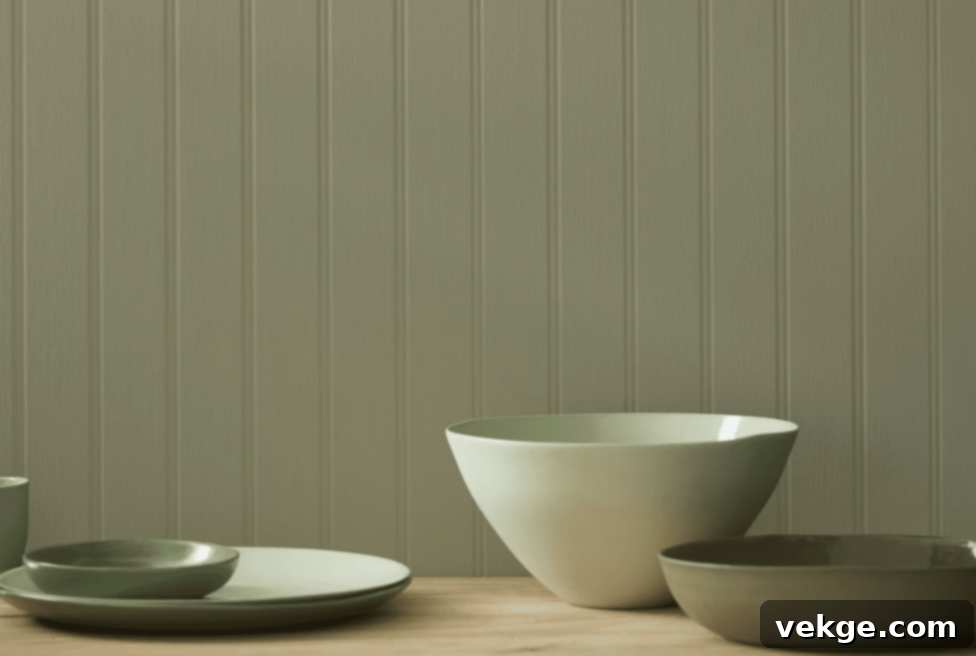
A deep, earthy olive green with subtle warm brown undertones, Tapenade by Benjamin Moore is perfect for creating a cozy, grounded, and intensely intimate atmosphere. Its richness adds significant depth to any room, making it an excellent choice for a bedroom seeking a warm, enveloping embrace.
Dark Olive by Behr
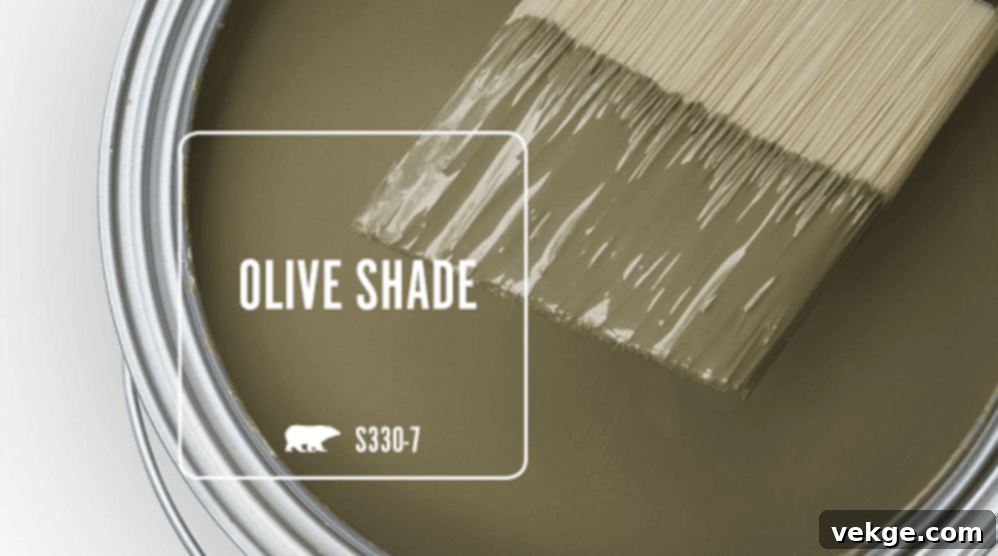
This rich, dark olive green exudes timeless elegance and profound depth. Dark Olive is particularly effective for accent walls, where it can create a dramatic focal point, or for cabinetry, bringing a sophisticated touch to your furnishings.
Ripe Olive SW 6209 by Sherwin-Williams

A deep, muted olive green, Ripe Olive by Sherwin-Williams brings a unique blend of warmth and sophisticated earthiness. It’s an ideal choice for crafting cozy, intimate spaces that feel both luxurious and inviting.
Cascades by Sherwin-Williams
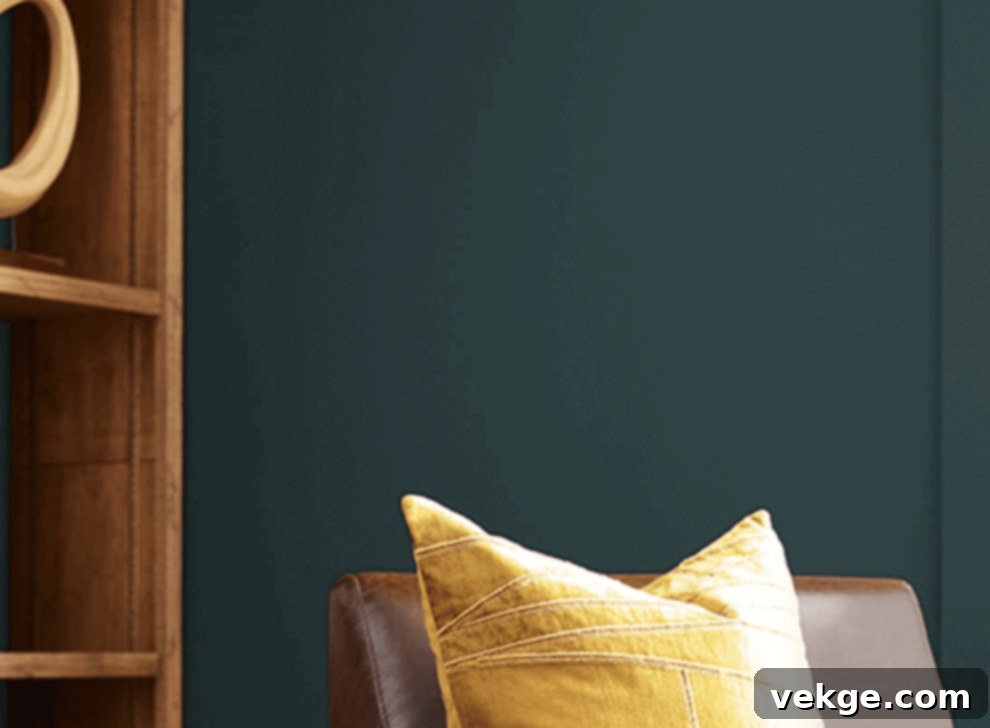
Cascades is a deep teal-green that beautifully marries the tranquility of blue with the grounding presence of green. It exudes a sense of calm and depth, making it perfectly suited for bedrooms or bathrooms where a serene and elegant environment is desired.
Green Smoke by Farrow & Ball

This exquisite smoky blue-green from Farrow & Ball offers a vintage charm while maintaining a thoroughly contemporary appeal. Green Smoke is ideal for creating rooms that feel cozy, inviting, and infused with a subtle, timeless elegance.
Tarrytown Green HC-134 by Benjamin Moore

Tarrytown Green is a rich, classic green with distinct blue undertones, evoking a strong sense of tradition and refined elegance. Its profound depth makes it a superb choice for adding gravitas and sophistication to living areas, studies, or a distinguished bedroom.
Expert Tips for Creating Your Dream Moody Green Bedroom Aesthetic
Building a green bedroom that perfectly captures that elusive moody yet inviting feel involves more than just paint. It’s about a holistic approach to design, layering elements to create a cohesive and deeply personal space. Here are some tested tips to help you bring your vision to life:
Layer Your Lighting for Ambience
Lighting is the soul of a moody aesthetic. Instead of relying on a single overhead light, create layers of illumination. Opt for soft, warm-toned bulbs (around 2700K) in all your fixtures. Place bedside lamps on nightstands for intimate task lighting and a gentle glow. Consider adding wall-mounted sconces or picture lights to highlight artwork or create ambient light without occupying floor space. A floor lamp strategically placed in a darker corner can add depth and eliminate harsh shadows. Crucially, install dimmers on all ceiling lights to allow complete control over the room’s brightness and mood, letting you adjust from a functional brightness to a cozy, muted glow with ease.
Mix Your Materials and Textures
Texture is vital for adding visual and tactile warmth, preventing a dark room from feeling flat. Blend different materials in your bedding: think crisp cotton sheets contrasted with a luxurious velvet duvet or an organic linen coverlet. Introduce chunky knit throws or soft wool blankets for ultimate coziness. Integrate wooden furniture pieces, from a reclaimed wood headboard to a sleek walnut dresser, to bring natural warmth. Incorporate reflective elements like glass vases, polished metal accents, or even a subtly mirrored tray to bounce light around the room, adding a touch of understated glamour without overwhelming the muted palette.
Embrace Natural Elements
To deepen the connection to nature and enhance the calming effects of green, incorporate living elements. Place small potted plants, such as a snake plant or a ZZ plant, on bedside tables or dressers. Hang air plants or delicate trailing vines near windows or from shelves for an ethereal touch. Vary the types of pots, using ceramic, terracotta, or even concrete in earthy tones to add textural interest. Choose low-light, easy-care indoor plants that thrive in bedroom conditions, ensuring they remain vibrant and healthy with minimal effort.
Keep Decor Simple and Intentional
In a moody aesthetic, less is often more. Overcrowding can detract from the serene, sophisticated feel. Choose 2-3 metal finishes at most for a cohesive look—perhaps brass and matte black, or brushed nickel and an aged bronze. When grouping decorative items, use the rule of odd numbers (groups of three or five) for a more visually pleasing arrangement. Leave ample open space on surfaces to allow individual pieces to breathe and make a statement. Prioritize larger, impactful statement pieces—like a striking piece of abstract art or a substantial decorative vase—over a multitude of small, cluttered items that can make the space feel busy rather than tranquil.
Master Color Balance with the 60-30-10 Rule
Achieving a balanced color scheme is crucial for any successful design. For a moody green bedroom, consider the 60-30-10 rule: approximately 60% of the room should be your dominant moody green, 30% a complementary neutral, and 10% an accent color. For a subtle yet impactful approach, paint just one accent wall in your chosen moody green. Integrate a deep neutral like charcoal gray or warm beige for 30% of the space through bedding, curtains, or an area rug. Finally, introduce 10% of an accent color—perhaps a rich rust, a deep plum, or a soft blush—through throw pillows, a piece of art, or a small decorative object. Adding touches of black can help ground the space, while strategic white elements (such as trim or a crisp white duvet cover) can introduce moments of brightness and prevent the room from feeling too enclosed.
16 Captivating Color Combination Ideas for a Moody Green Bedroom
Once you’ve chosen your perfect shade of green, the next step is to find its ideal partners. These color combinations are designed to enhance the moody aesthetic, adding depth, warmth, and personality to your green bedroom.
1. Deep Green and Brass
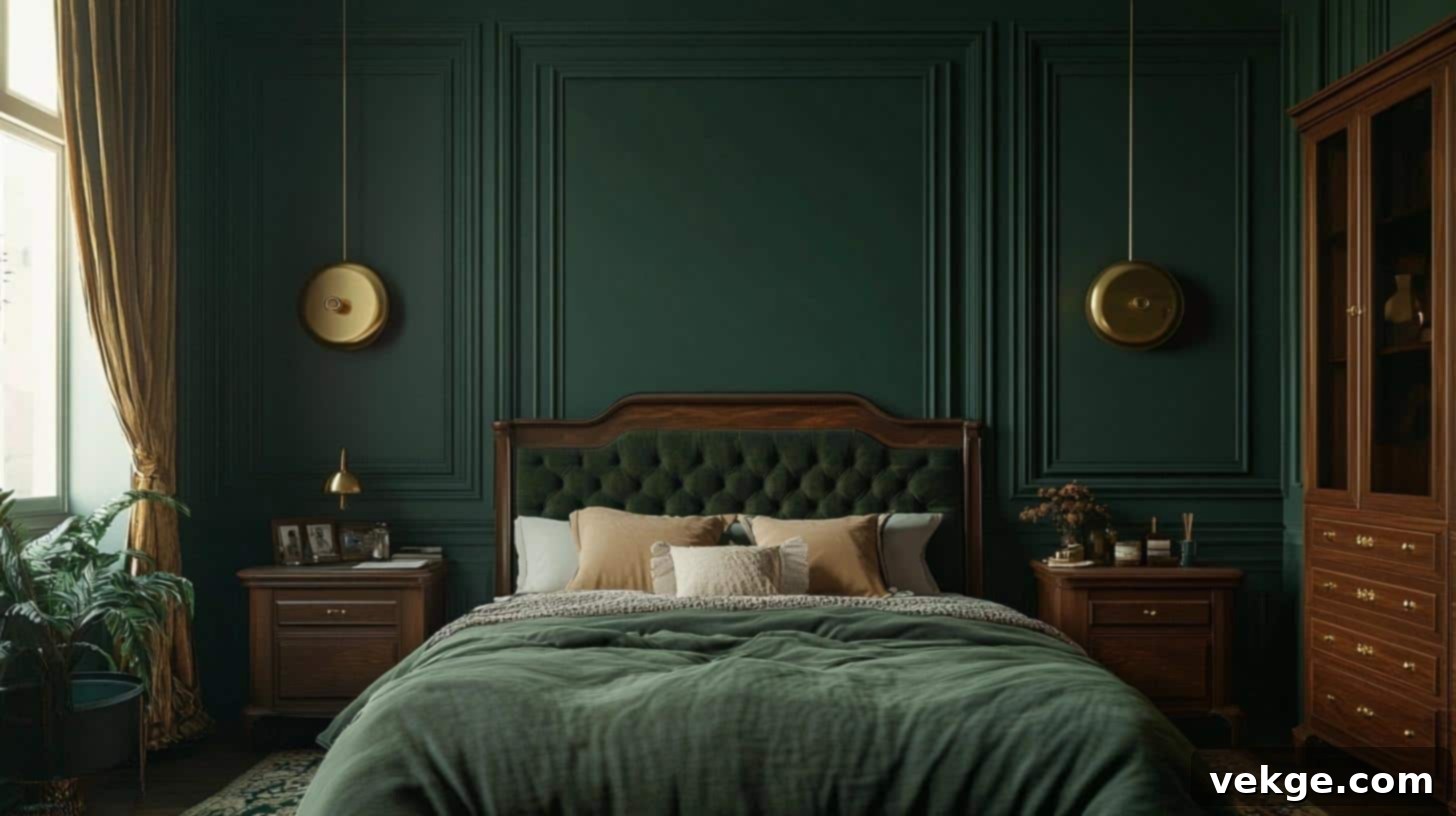
- Why It Works: This combination exudes an opulent, vintage-inspired luxury. The warm, golden gleam of brass beautifully contrasts and elevates deep green, adding a sophisticated touch and a sense of timeless elegance.
- Complementary Decor Elements: Introduce brass light fixtures (pendants or sconces), accent with dark wooden furniture like a walnut dresser, and select rich velvet textiles for pillows or curtains to enhance the luxurious feel.
2. Pine Green and White

- Why It Works: Crisp and clean, this pairing creates a refreshing yet moody feel. The white provides a bright contrast that prevents the pine green from feeling too heavy, opening up the space while maintaining its serene depth.
- Complementary Decor Elements: Opt for crisp white linens and duvets, incorporate natural light wood accents in furniture or frames, and enhance the natural vibe with abundant greenery like potted plants or hanging vines.
3. Dark Green and Charcoal Blue

- Why It Works: Cool, calming, and profoundly sophisticated, this combination is ideal for a modern, moody retreat. The cool undertones of charcoal blue seamlessly blend with dark green, creating a harmonious and serene atmosphere.
- Complementary Decor Elements: Select charcoal gray curtains or a rug, introduce navy blue decorative pillows, and choose black metal lighting fixtures for a sleek, contemporary touch.
4. Sage Green and Antique White
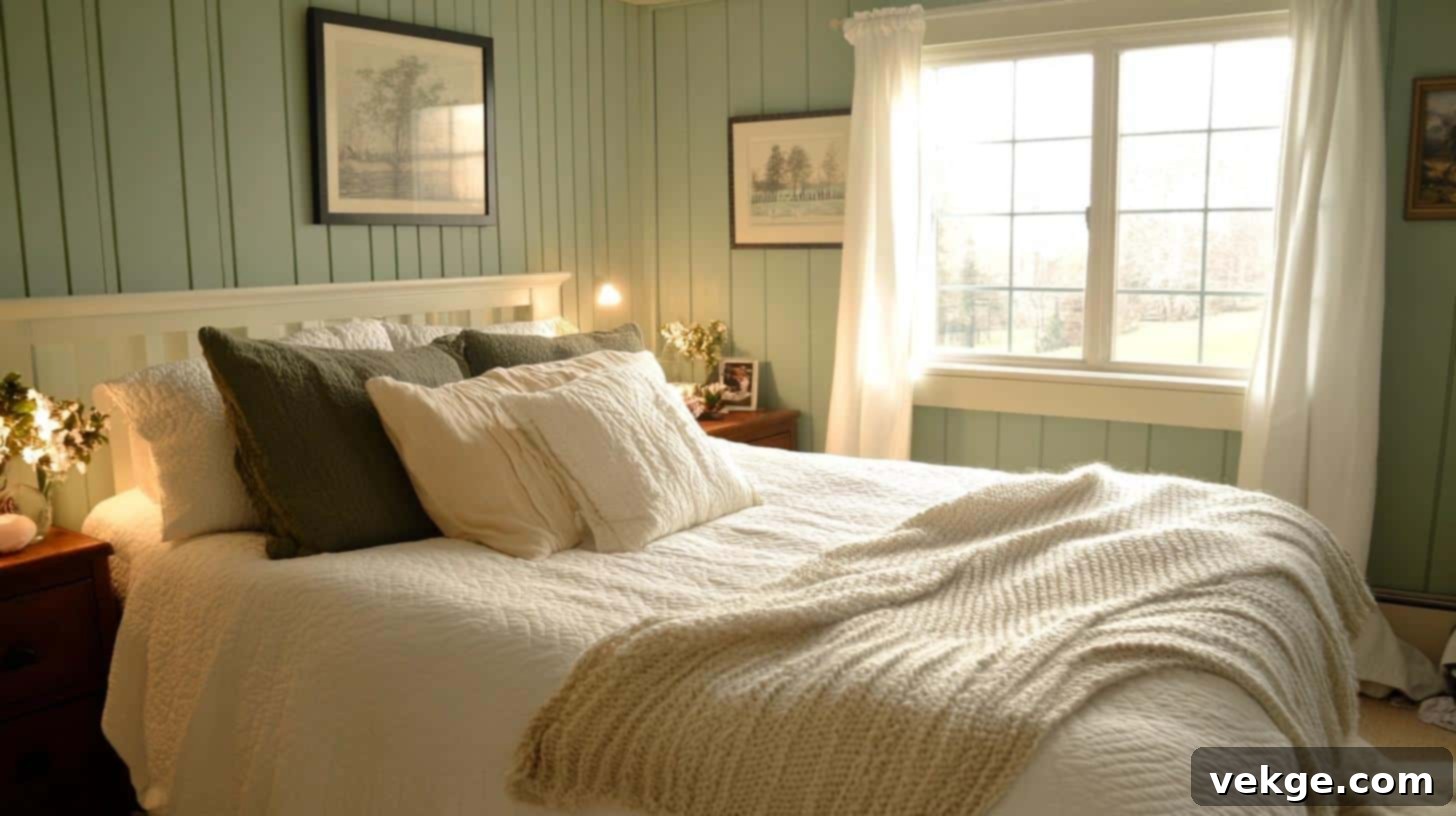
- Why It Works: Soft and serene, this lighter combination still manages to feel incredibly cozy. The muted, earthy tone of sage green pairs beautifully with the creamy warmth of antique white, creating an airy yet comforting environment.
- Complementary Decor Elements: Incorporate whitewashed wood furniture, soft gray accents in throws or cushions, and layer with cozy knit blankets to enhance the inviting feel.
5. Emerald Green and Blush Pink
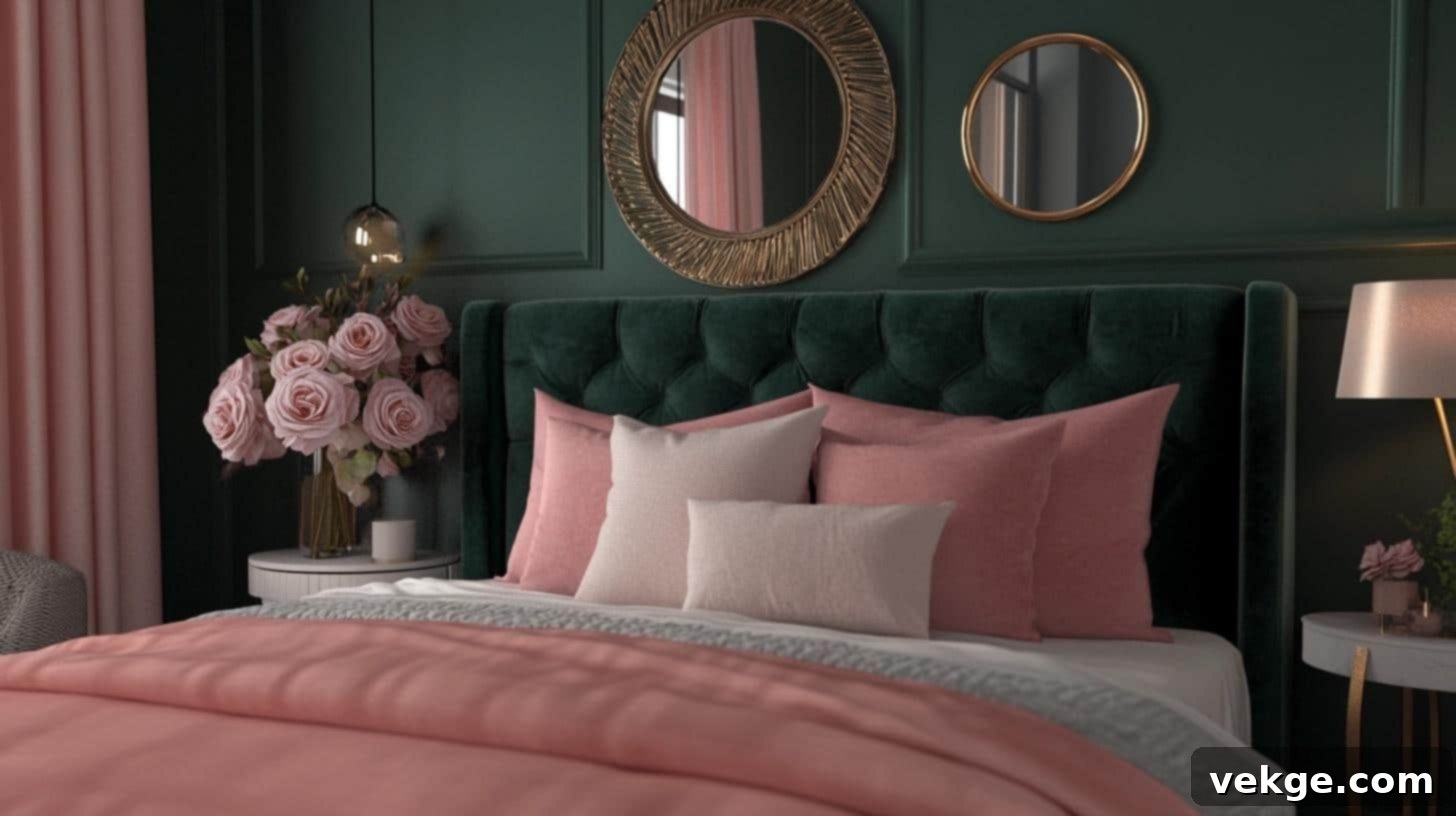
- Why It Works: This unexpected duo adds a soft, romantic feel with a luxurious touch of glamor. The gentle warmth of blush pink beautifully softens the boldness of emerald green, creating a charming and chic contrast.
- Complementary Decor Elements: Introduce blush pink pillows and throws, incorporate gold-framed mirrors or decor, and consider an emerald green velvet headboard for a truly striking statement.
6. Teal and Chocolate Brown
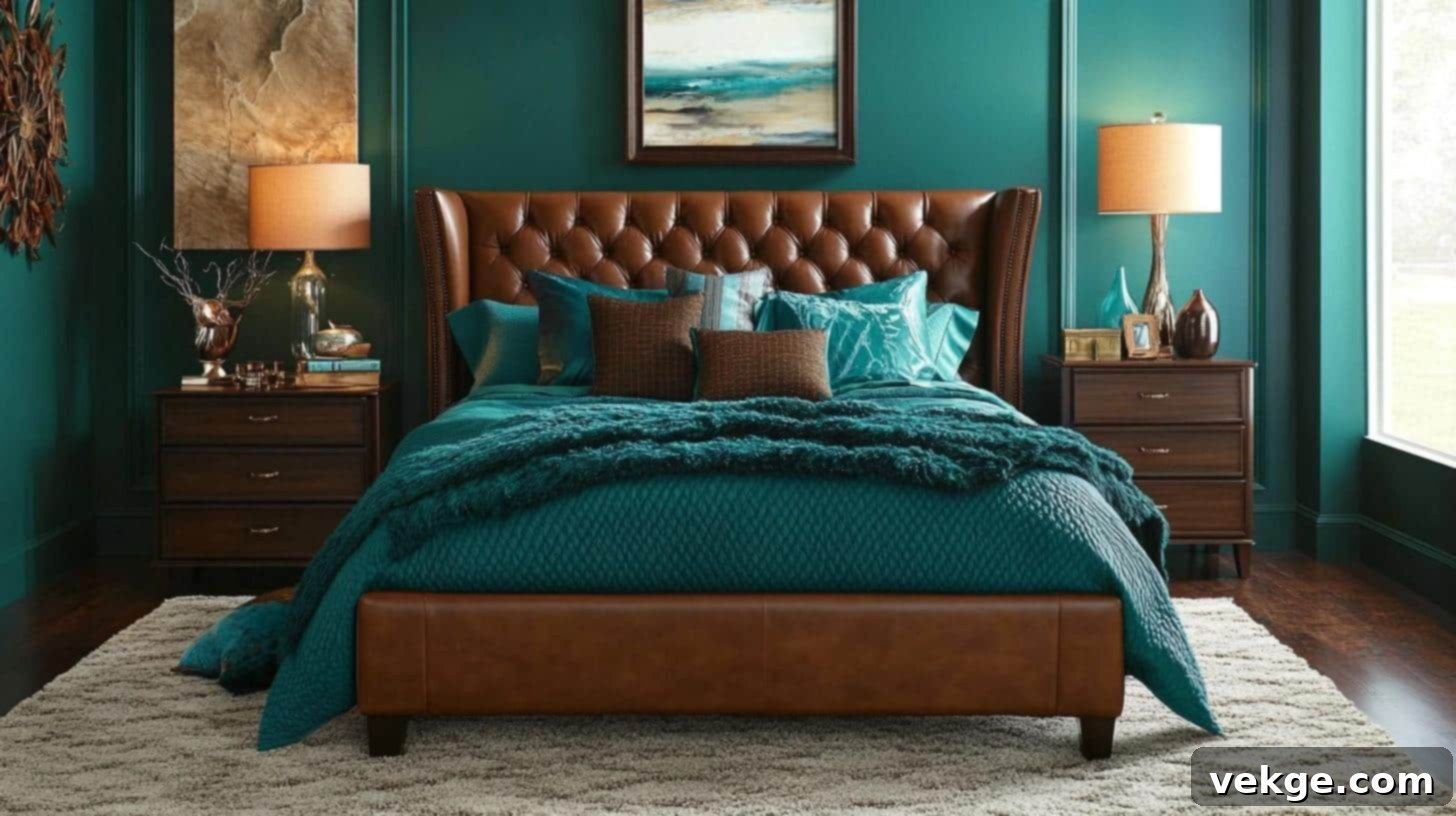
- Why It Works: Rich and earthy, this combination creates a deeply luxurious and warm atmosphere. The depth of teal harmonizes with the grounding quality of chocolate brown, lending an organic yet sophisticated feel.
- Complementary Decor Elements: Integrate brown leather furniture accents (like a reading chair), use teal throw pillows or an area rug, and opt for dark wood finishes on nightstands or a dresser.
7. Mint Green and Pewter Gray
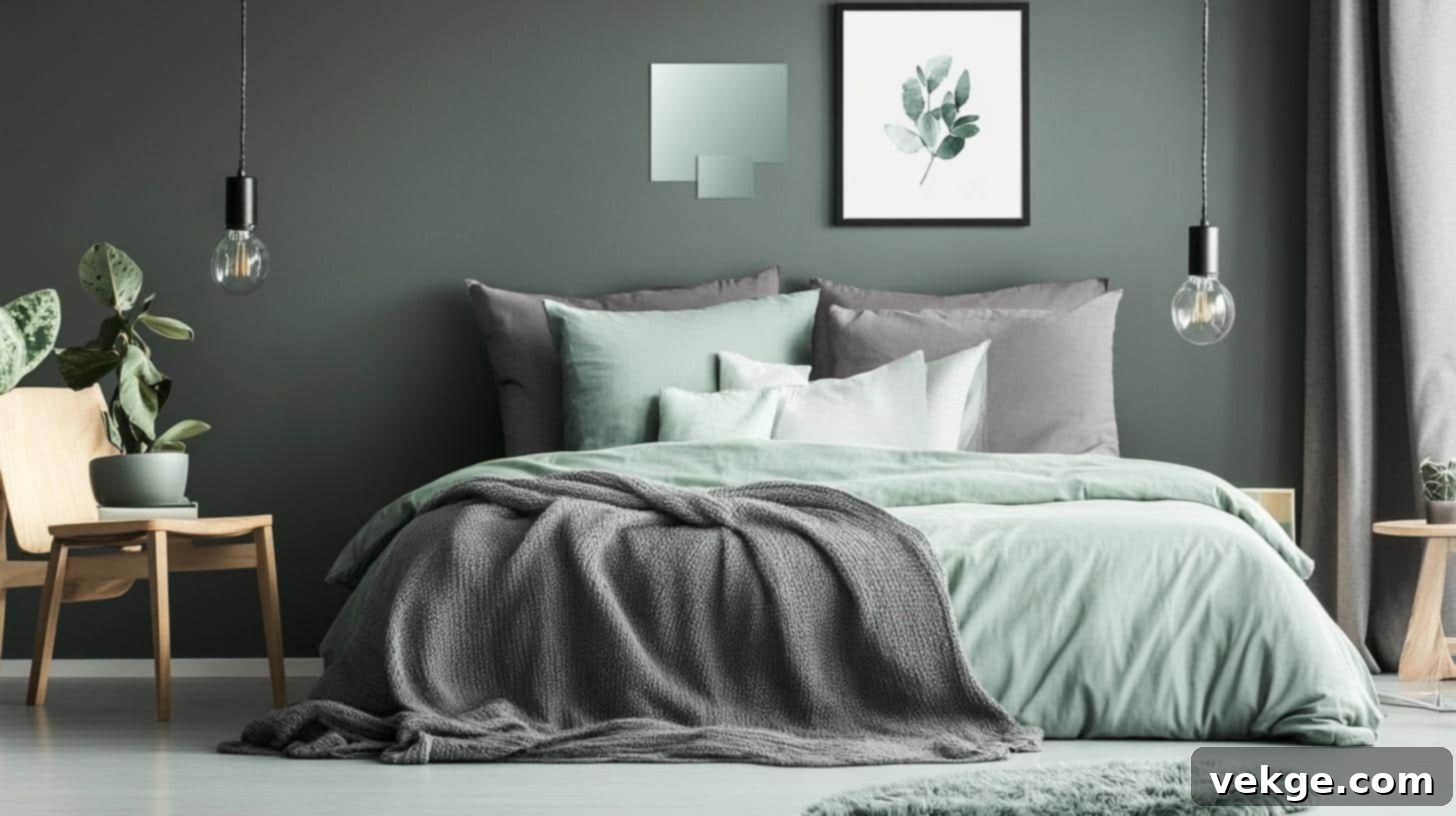
- Why It Works: Clean, modern, and refreshingly subtle, this duo offers a gentle take on the moody aesthetic. The coolness of mint green brings freshness, while pewter gray adds a sophisticated and calming balance.
- Complementary Decor Elements: Feature pewter light fixtures or hardware, use light wood accents to maintain brightness, and keep decor minimalist for a sleek, contemporary look.
8. Army Green and Rust Red
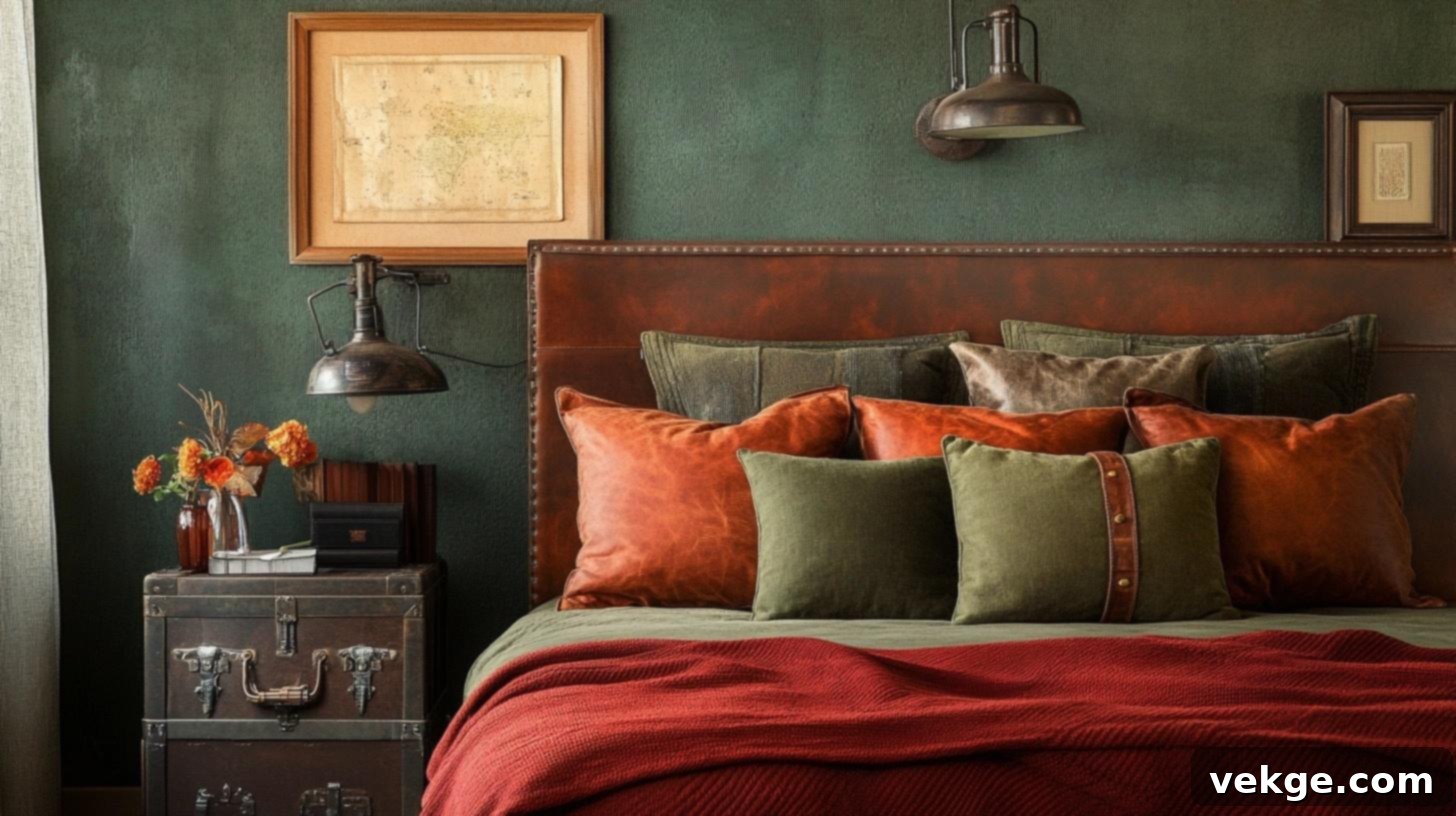
- Why It Works: Bold and rustic, this combination is excellent for a cozy, eclectic, and grounded aesthetic. The earthy army green is invigorated by the vibrant warmth of rust red, creating a dynamic and inviting feel.
- Complementary Decor Elements: Introduce rust red pillows, throws, or a small accent rug. Incorporate vintage furniture pieces and add touches of leather for a truly authentic, rugged charm.
9. Pine Green and Soft Gray
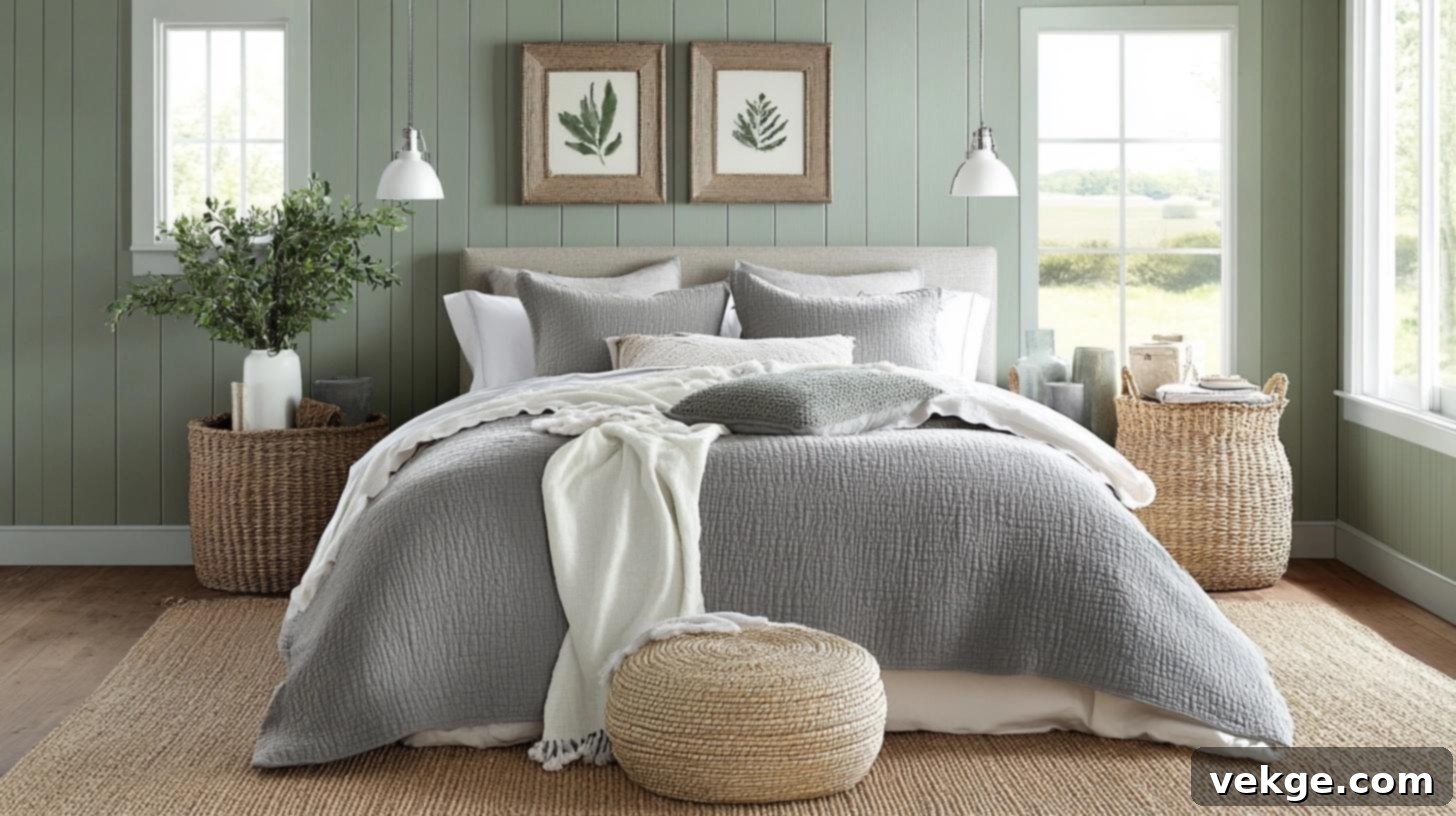
- Why It Works: Muted yet fresh, this pairing is ideal for a relaxed, understated bedroom that still feels deeply calming. The soft gray acts as a gentle counterpoint to the pine green, promoting a tranquil ambiance.
- Complementary Decor Elements: Choose soft gray bedding and an area rug, integrate woven baskets for storage, and select other neutral elements like ceramic vases or natural wood accents.
10. Olive Green and Terracotta
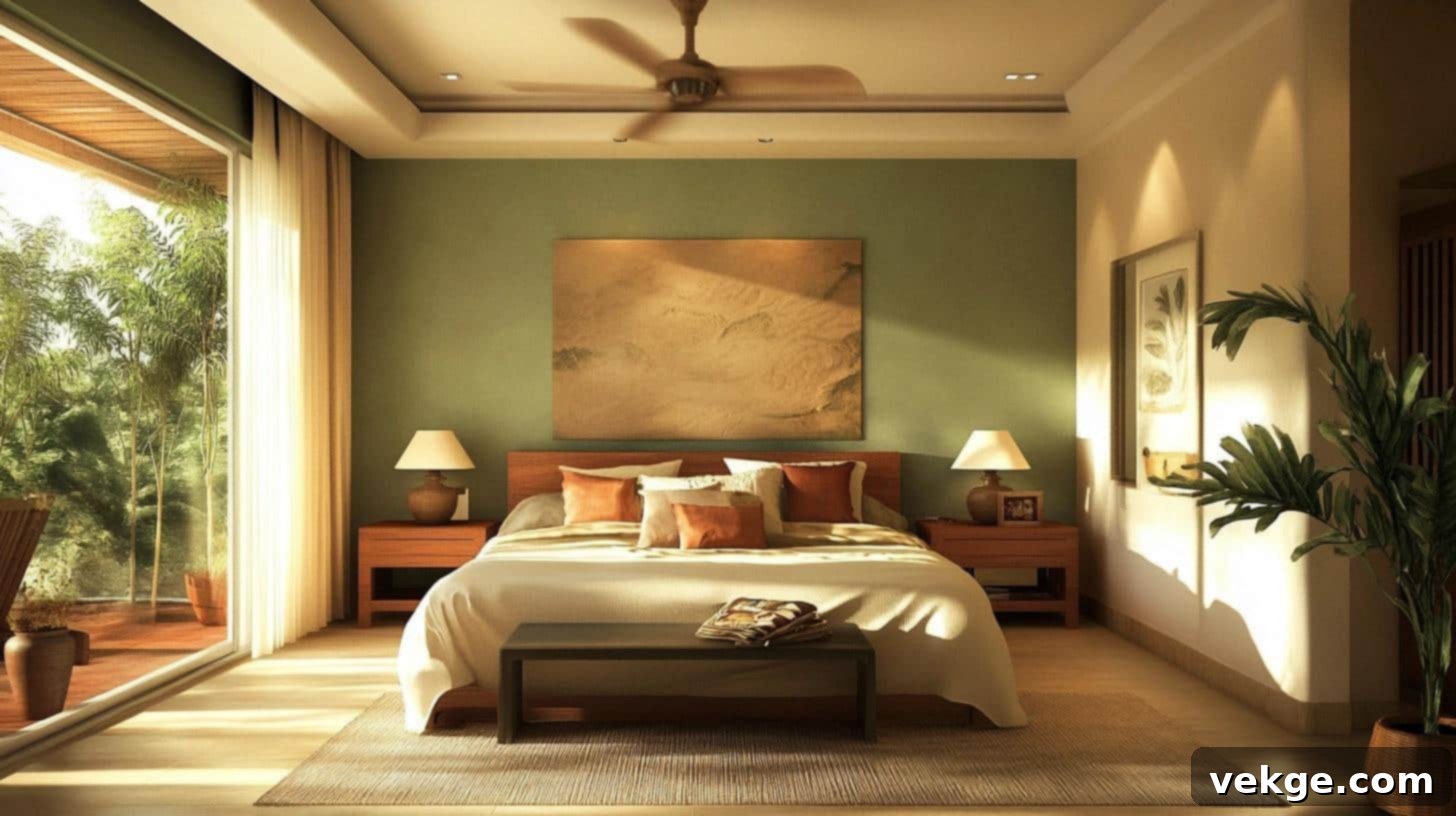
- Why It Works: Earthy and incredibly inviting, this combination feels wonderfully warm and stylish. The warm, rustic tones of terracotta beautifully complement the sophisticated depth of olive green, creating a grounded and cozy look.
- Complementary Decor Elements: Display terracotta pots with plants, opt for natural wood furniture, and integrate beige or cream throw pillows to tie the earthy palette together.
11. Sage Green and Brass Accents
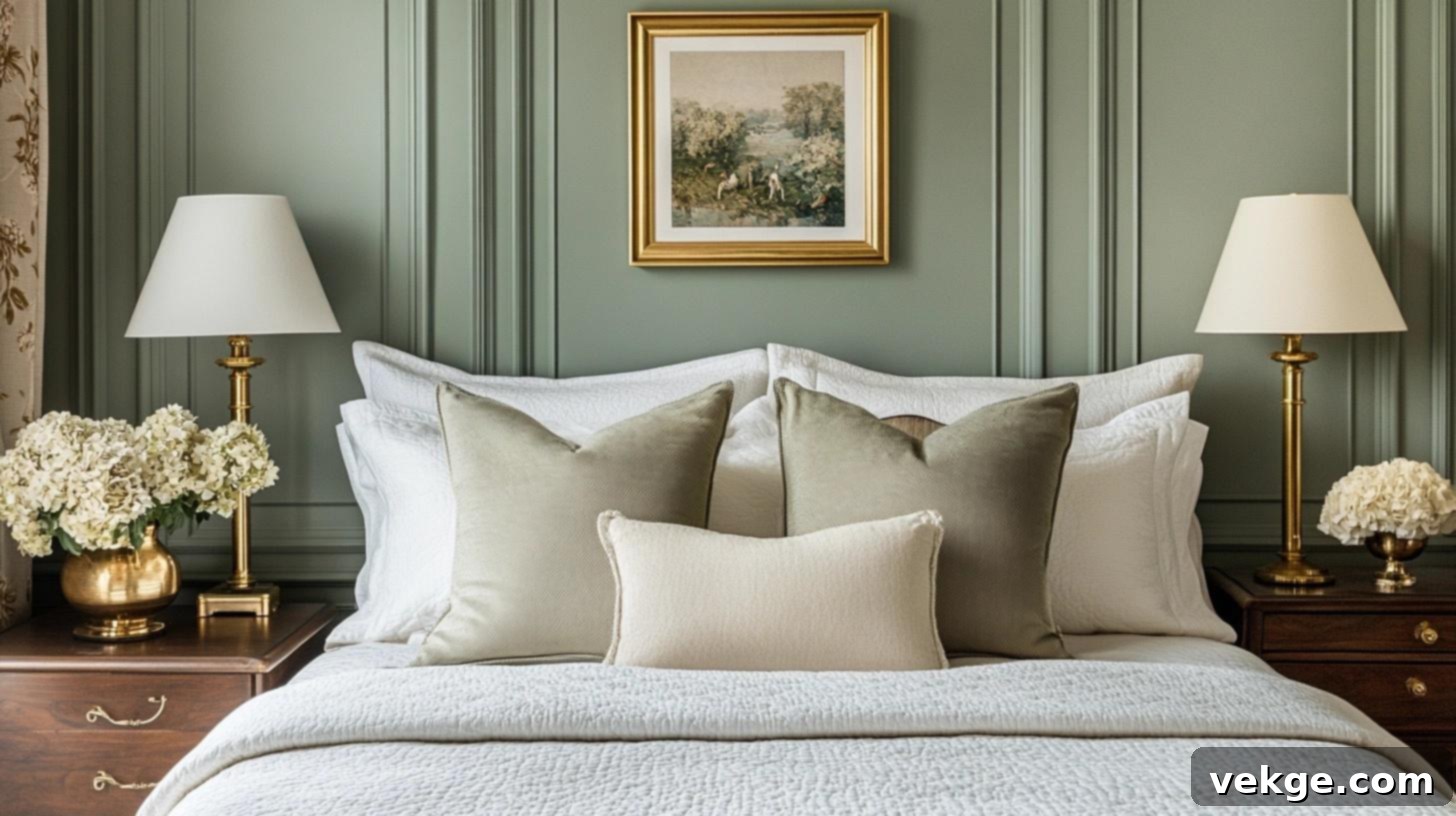
- Why It Works: This pairing is understated and effortlessly classy, with brass providing a hint of luxe without overwhelming the soft sage. The warmth of brass elevates sage green, adding a touch of sophistication.
- Complementary Decor Elements: Feature brass lamps, light wood finishes on furniture, and soft cream bedding to maintain an airy yet elegant feel.
12. Olive Green and Burgundy
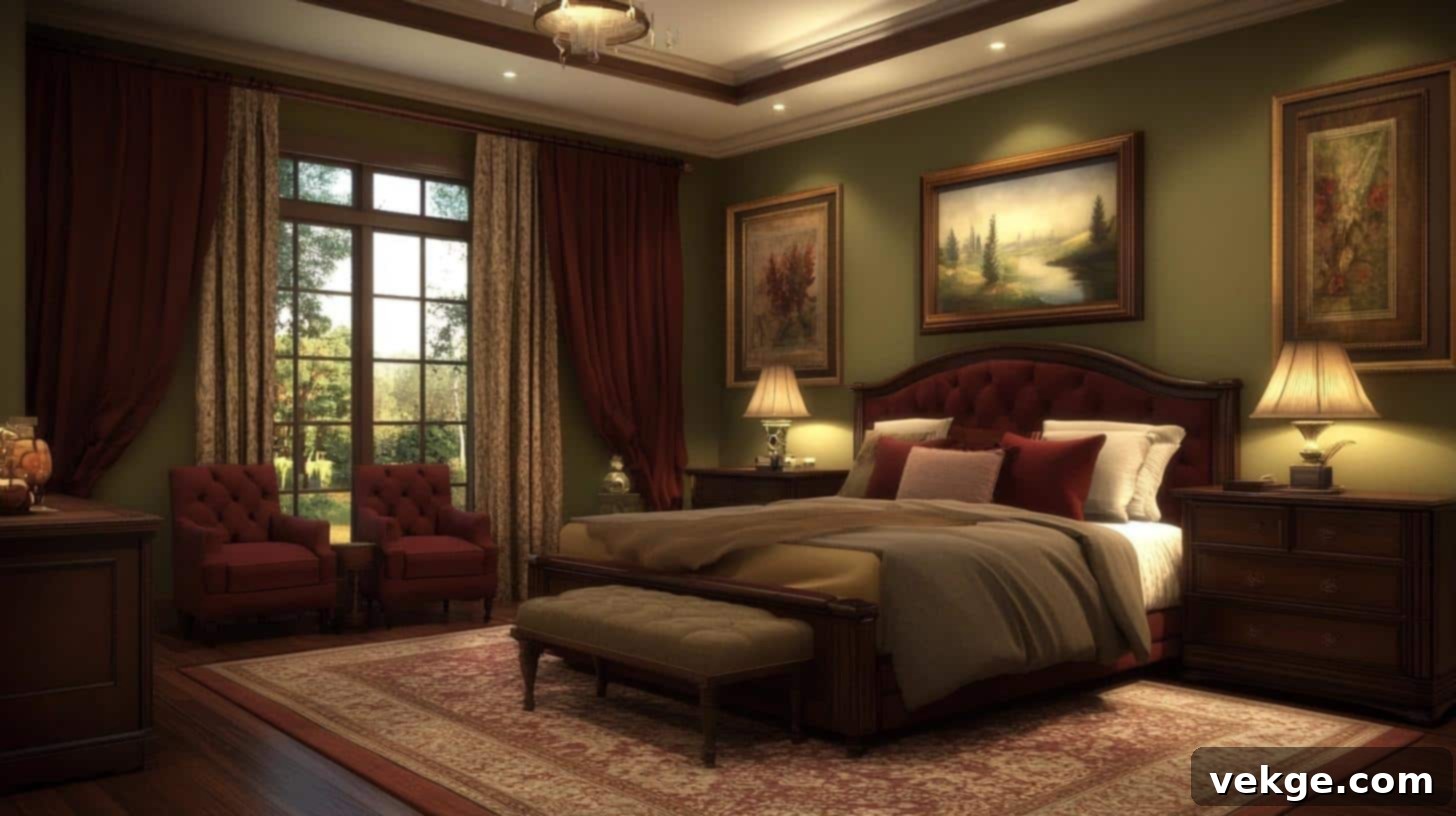
- Why It Works: Deep and undeniably luxurious, this duo creates a mature, warm, and highly inviting space. The rich, jewel-toned burgundy adds profound depth and a touch of romance to the earthy olive green.
- Complementary Decor Elements: Introduce burgundy velvet throw pillows or a plush blanket, select dark wooden furniture pieces, and incorporate subtle gold accents for an added layer of opulence.
13. Sea Green and Dark Wood
- Why It Works: This combination adds an organic, naturally inspired feel, perfect for a calming retreat reminiscent of a deep forest or tranquil sea. The cool tranquility of sea green is beautifully grounded by the richness of dark wood.
- Complementary Decor Elements: Incorporate natural elements like wicker baskets, strategically placed indoor plants, and soft linen bedding in neutral tones to enhance the organic vibe.
14. Sage Green and Dusty Rose
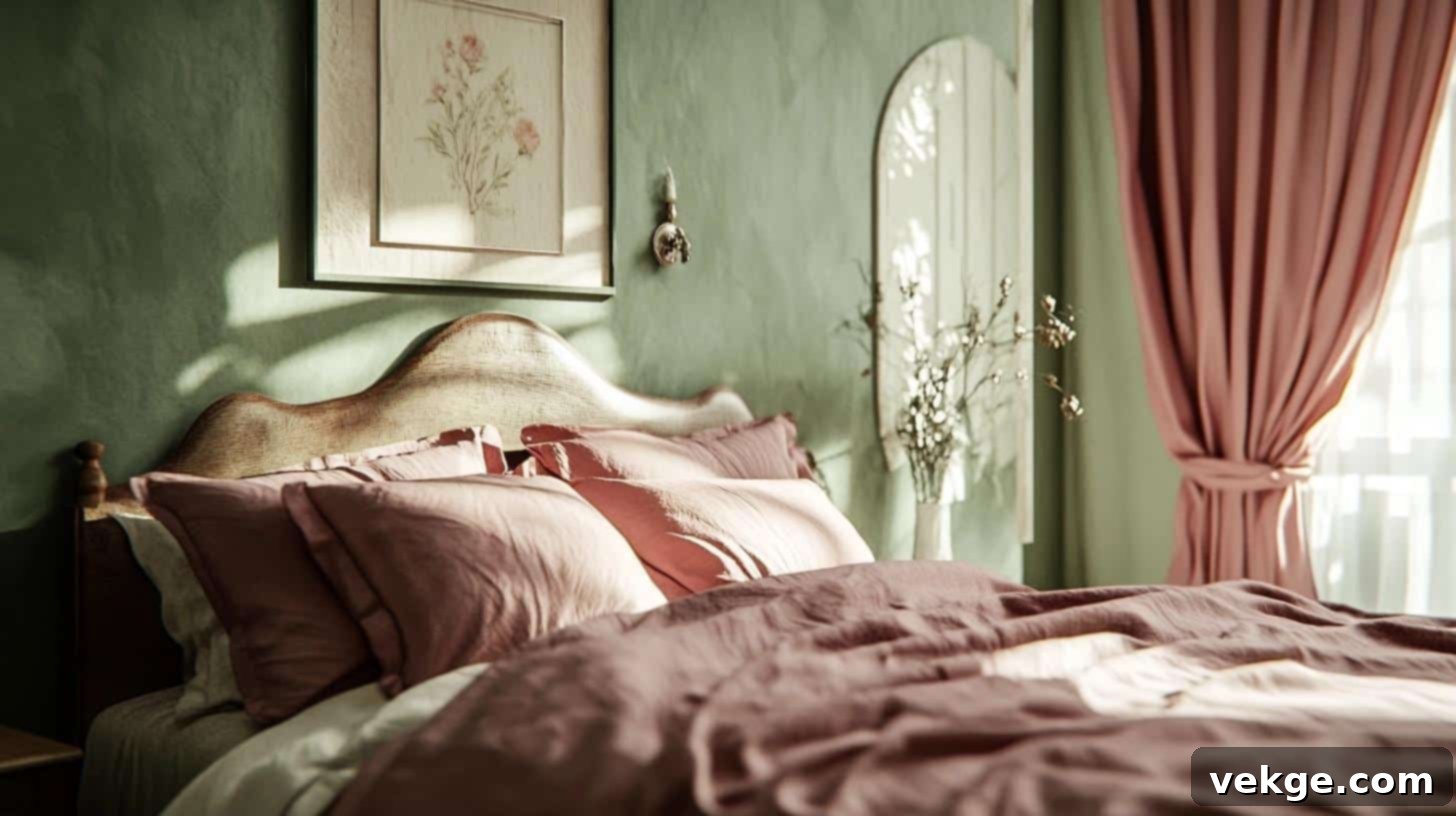
- Why It Works: Soft, gentle, and subtly moody, this pair brings a delicate, romantic touch to the bedroom. The muted tones of sage green and dusty rose create a soothing atmosphere with a quiet, elegant charm.
- Complementary Decor Elements: Adorn the bed with dusty rose pillows and throws, select vintage-inspired wall art, and choose sage green bed linens for a cohesive and dreamy look.
15. Moss Green and Walnut Brown
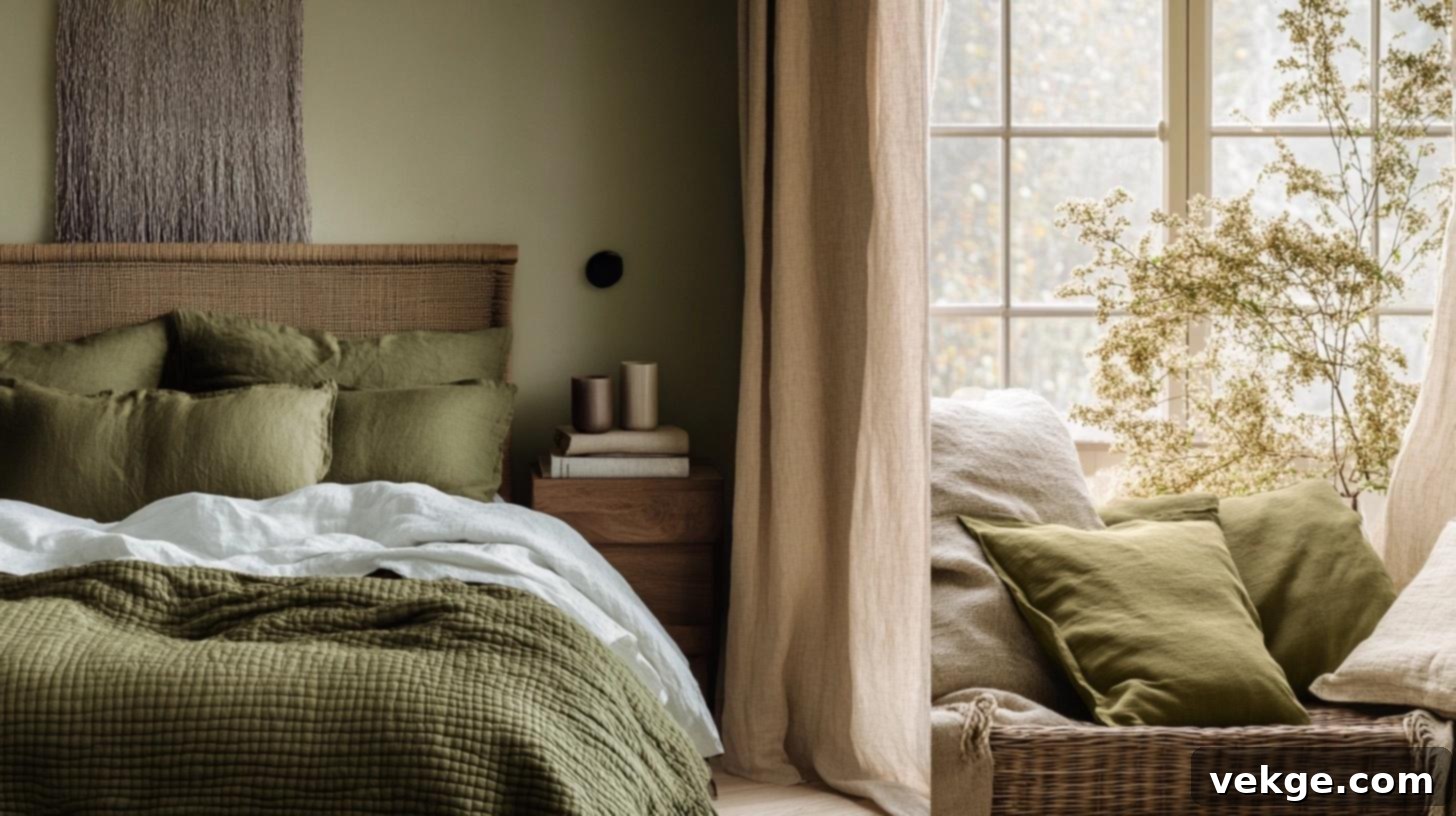
- Why It Works: Earthy and deeply cozy, this duo evokes the natural beauty of a forest floor. The organic moss green blends seamlessly with the rich, warm tones of walnut brown, adding a natural feel with a hint of understated luxury.
- Complementary Decor Elements: Invest in walnut wood furniture, integrate woven textures through rugs or decorative baskets, and add moss green throw blankets for a layered, comfortable look.
16. Hunter Green and Burnt Orange
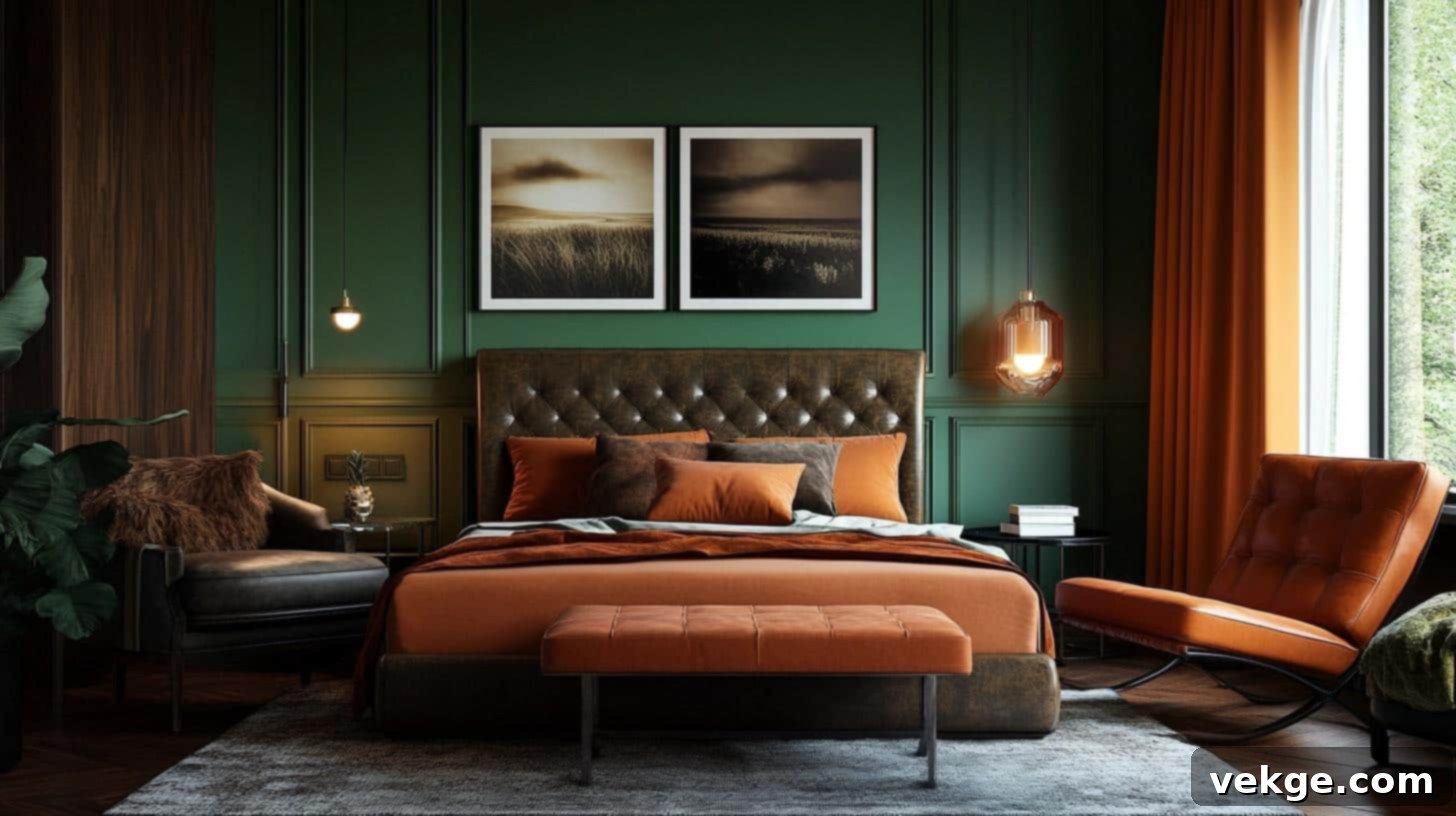
- Why It Works: This bold yet harmonious mix brings warmth and significant depth, giving the room a rich, autumnal, and profoundly inviting vibe. The vibrant burnt orange acts as a striking, cozy contrast to the deep hunter green.
- Complementary Decor Elements: Feature burnt orange cushions or a statement throw, incorporate rich leather accents (like a bedside tray or stool), and choose dark green curtains to frame the windows elegantly.
DIY Your Own Moody Green Accent Wall in Your Bedroom
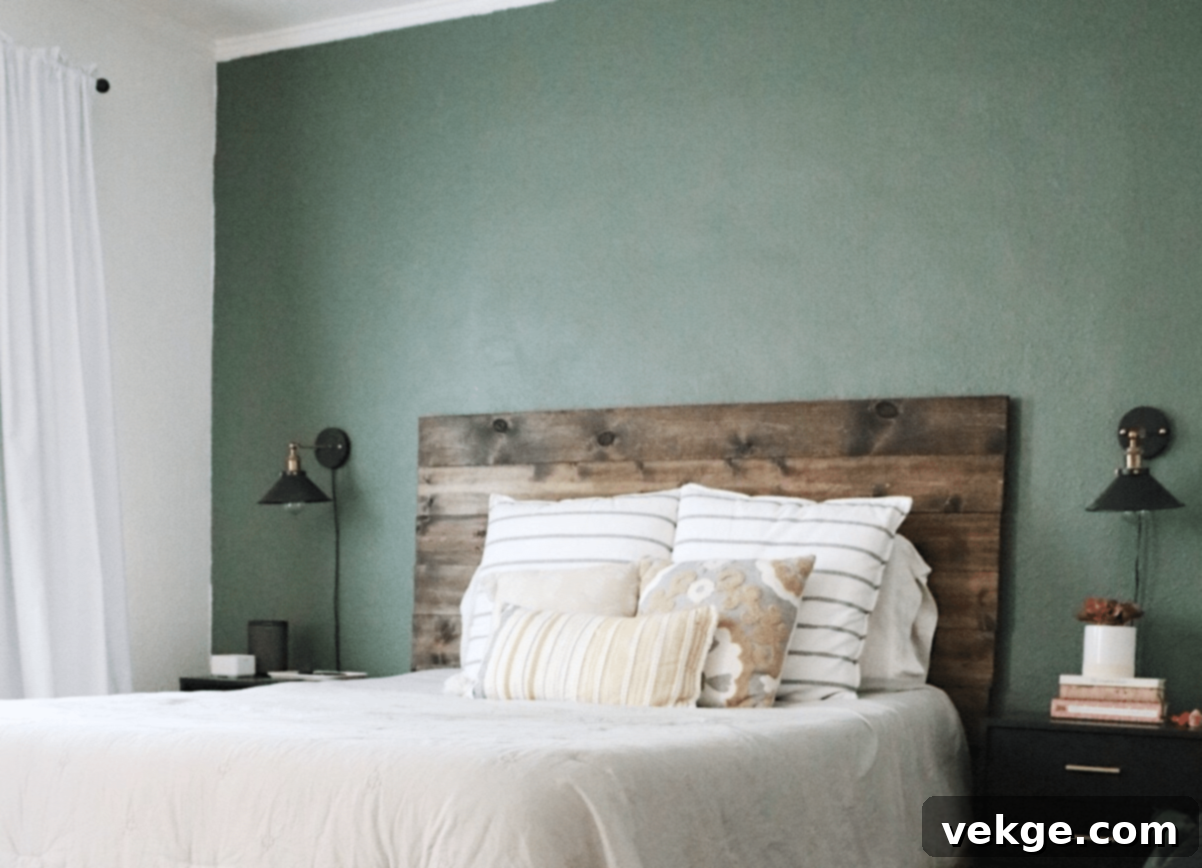
An accent wall is a fantastic way to introduce a moody green into your bedroom without committing to painting the entire room. It creates a focal point, adds depth, and can dramatically transform the space with relatively little effort. Here’s a simple guide to creating your own stunning moody green accent wall.
Tools and Materials Required
| Tools | Materials |
|---|---|
| Paint roller and tray | Moody green wall paint (e.g., Benjamin Moore Tapenade or Sherwin-Williams Ripe Olive) |
| Paintbrush (angled for precision) | Wall primer (essential for color change or uneven surfaces) |
| Painter’s tape (high-quality for sharp lines) | Wall filler or spackle |
| Sandpaper (fine-grit) | Drop cloths or old sheets (for floor protection) |
| Stir stick | Damp cloth and bucket of water (for cleaning) |
Step-by-Step Guide to Your Accent Wall
Step 1: Prepare the Wall for Painting
- Begin by thoroughly cleaning the accent wall with a damp cloth or a mild cleaner to remove any dust, dirt, or grease. This ensures proper paint adhesion.
- Inspect the wall for any holes, cracks, or imperfections. Use wall filler or spackle to patch these areas, then allow them to dry completely. Once dry, gently sand the patched areas smooth with fine-grit sandpaper, then wipe away any dust.
- Carefully apply painter’s tape along the edges of the wall where it meets the ceiling, adjacent walls, baseboards, and around any windows or door frames. Press the tape firmly to create a crisp, clean line and prevent paint bleed. Cover your floor and nearby furniture with drop cloths.
Step 2: Apply Wall Primer (If Necessary)
- If your current wall color is significantly lighter or darker than your chosen moody green, or if the wall surface is inconsistent, applying a primer is highly recommended. Primer helps to create a uniform surface for the paint, improves color saturation, and ensures a smooth, even finish.
- Using your paint roller, apply a thin, even coat of primer to the entire accent wall. Allow it to dry completely according to the manufacturer’s instructions, typically a few hours.
Step 3: Apply the Moody Green Paint
- Before painting, thoroughly stir your moody green paint with a stir stick to ensure the pigments are evenly mixed.
- Start by “cutting in” the edges and corners of the wall using your angled paintbrush. Paint a 2-3 inch wide strip along the taped edges.
- Immediately after cutting in, use your paint roller for the main surface of the wall. Load the roller evenly with paint and apply it in W-shaped or M-shaped strokes, overlapping slightly to ensure even coverage. Work in sections, moving from top to bottom.
- Allow the first coat of paint to dry completely. Depending on the paint and color, this usually takes 2-4 hours. For a deeper, richer, and more even color saturation, apply a second coat, repeating the cutting-in and rolling process.
Step 4: Final Touches and Decorating
- Once the second coat of paint is dry to the touch (but not fully cured—removing tape too late can cause peeling), carefully and slowly remove the painter’s tape at a 45-degree angle. If any paint has seeped under the tape or there are small drips, gently clean them up with a damp cloth or a small detail brush.
- Step back and admire your new moody green accent wall! Now, enhance its impact by adding carefully chosen decor. Hang a striking piece of artwork, install a floating shelf with a few select objects, or strategically place lighting to highlight the beautiful new color.
Wrapping It Up: Your Journey to a Tranquil Green Retreat
Creating a moody green bedroom is much more than just selecting a paint color; it’s about curating a space that deeply resonates with your desire for peace, comfort, and personal style. We’ve explored how the inherent qualities of green can profoundly impact your well-being, from reducing stress and improving sleep quality to fostering mental clarity and connection to nature.
We delved into the essence of the moody aesthetic, defining it as a sophisticated blend of depth, texture, and intimate lighting, rather than mere darkness. You now have a curated selection of perfect moody green shades, along with practical, actionable tips on layering lighting, mixing materials, incorporating natural elements, and balancing your color palette to achieve a harmonious design.
With 16 inspiring color combinations and a step-by-step guide to creating your own accent wall, you have all the tools to embark on this exciting transformation. Remember, you don’t need to overhaul everything at once. Start small if you prefer—perhaps with a lush green throw pillow, a statement plant, or a new piece of art that features your chosen hue. Observe how these subtle additions begin to shift the room’s atmosphere, then build upon that feeling.
Your journey to a stunning moody green bedroom begins now. I’d love to hear about your plans and see your beautiful transformations! Share your preferred color choices or design ideas in the comments below. And for more inspiration, don’t forget to explore my guide on picking the perfect bedroom lighting to truly illuminate and enhance your new green sanctuary.
